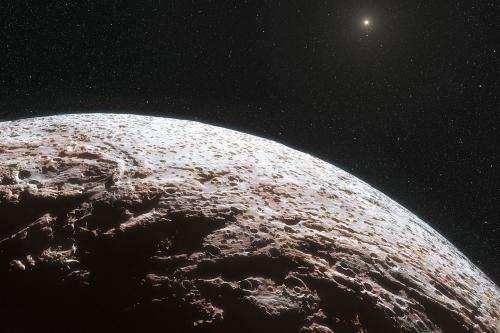This artists impression shows the surface of the distant dwarf planet Makemake. This dwarf planet is about two thirds of the size of Pluto, and travels around the Sun in a distant path that lies beyond that of Pluto, but closer to the Sun than Eris, the most massive known dwarf planet in the Solar System. Makemake was expected to have an atmosphere like Pluto, but this has now been shown to not be the case. Credit: ESO/L. Calçada/Nick Risinger
Astronomers have used three telescopes at ESO's observatories in Chile to observe the dwarf planet Makemake as it drifted in front of a distant star and blocked its light. The new observations have allowed them to check for the first time whether Makemake is surrounded by an atmosphere. The scientists also measured Makemake's density for the first time. The new results are to be published in the Nov. 22 issue of the journal Nature.
Makemake was initially known as 2005 FY9. It was discovered a few days after Easter in March 2005, earning it the informal nickname of Easterbunny. In July 2008 it was given the official name of Makemake. Makemake is the creator of humanity and god of fertility in the myths of the native people of Easter Island. Makemake is one of five dwarf planets so far recognised by the International Astronomical Union. The others are Ceres, Pluto, Haumea and Eris.
Dwarf planet Makemake is about two thirds of the size of Pluto, and travels around the Sun in a distant path that lies beyond that of Pluto but closer to the Sun than Eris, the most massive known dwarf planet in the Solar System. Previous observations of chilly Makemake have shown it to be similar to its fellow dwarf planets, leading some astronomers to expect its atmosphere, if present, to be similar to that of Pluto. However, the new study now shows that, like Eris, Makemake is not surrounded by a significant atmosphere.
The team, led by Jose Luis Ortiz (Instituto de Astrofisica de Andalucia, CSIC, Spain), combined multiple observations using three telescopes at ESO's La Silla and Paranal observing sites in Chile—the Very Large Telescope (VLT), New Technology Telescope (NTT), and TRAPPIST (TRAnsiting Planets and PlanetesImals Small Telescope)—with data from other small telescopes in South America, to look at Makemake as it passed in front of a distant star.
"As Makemake passed in front of the star and blocked it out, the star disappeared and reappeared very abruptly, rather than fading and brightening gradually. This means that the little dwarf planet has no significant atmosphere," says Jose Luis Ortiz. "It was thought that Makemake had a good chance of having developed an atmosphere—that it has no sign of one at all shows just how much we have yet to learn about these mysterious bodies. Finding out about Makemake's properties for the first time is a big step forward in our study of the select club of icy dwarf planets."
Makemake's lack of moons and its great distance from us make it difficult to study, and what little we do know about the body is only approximate. The team's new observations add much more detail to our view of Makemake—determining its size more accurately, putting constraints on a possible atmosphere and estimating the dwarf planet's density for the first time. They have also allowed the astronomers to measure how much of the Sun's light Makemake's surface reflects—its albedo. Makemake's albedo, at about 0.77, is comparable to that of dirty snow, higher than that of Pluto, but lower than that of Eris.
It was only possible to observe Makemake in such detail because it passed in front of a star—an event known as a stellar occultation. These rare opportunities are allowing astronomers for the first time to find out a great deal about the sometimes tenuous and delicate atmospheres around these distant, but important, members of the Solar System, and providing very accurate information about their other properties.
Occultations are particularly uncommon in the case of Makemake, because it moves in an area of the sky with relatively few stars. Accurately predicting and detecting these rare events is extremely difficult and the successful observation by a coordinated observing team, scattered at many sites across South America, ranks as a major achievement.
"Pluto, Eris and Makemake are among the larger examples of the numerous icy bodies orbiting far away from our Sun," says Jose Luis Ortiz. "Our new observations have greatly improved our knowledge of one of the biggest, Makemake—we will be able to use this information as we explore the intriguing objects in this region of space further."
More information: This research was presented in a paper "Albedo and atmospheric constraints of dwarf planet Makemake from a stellar occultation" to appear in the 22 November 2012 issue of the journal Nature.
Journal information: Nature
Provided by ESO
























